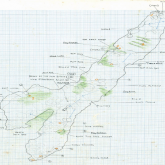Week 32: E.A.T. (Experiments in Art and Technology)
Hi Everyone,
This Tuesday is another event in a year-long series of weekly conversations and exhibits in 2010 shedding light on examples of Plausible Artworlds.
This week we’ll be talking with Julie Martin, one of the founders — with artist Robert Rauschenberg and Billy Klüver, then a research scientist at Bell Laboratories — of Experiments in Art and Technology (E.A.T.), a groundbreaking initiative in the late 1960s that brought artists, engineers and scientists together in an attempt to rethink and to overcome the split between the worlds of art, science and technology that had come to characterize and warp modernity.
A series of performances organized in 1966 incorporating video projection, wireless sound transmission, and Doppler sonar — now commonplace but at the time emergent technologies, still untried in art production — laid the way for the group’s founding in 1967. Until the early 1980s (and the beginning of the Reagan era), E.A.T. promoted interdisciplinary collaborations through a program pairing artists and engineers. It also encouraged research into new means of expression at the crossroads of art and such emerging technologies as computer-generated images and sounds, satellite transmission, synthetic materials and robotics.
http://en.wikipedia.org/wiki/Experiments_in_Art_and_Technology
http://www.fondation-langlois.org/html/e/page.php?NumPage=237
The whole experiment, with all its utopian energy, is somehow reminiscent of a Thomas Pynchon novel: born of a union between the anything-is-plausible outlook typical of art and science at the time and the blossoming technology industries indirectly funded by the Vietnam war, E.A.T. is undoubtedly one of the most inspiring and emblematic attempts ever undertaken to bridge the gap between the worlds of art and technique. As instructive in its measurable success as in its ultimate inability to correct for the ideological bias inherent to an industrial laboratory, E.A.T. continues to point to a horizon shared by many collectives today — as for instance in its 1969 call for PROJECTS OUTSIDE ART, dealing with such issues as “education, health, housing, concern for the natural environment, climate control, transportation, energy production and distribution, communication, food production and distribution, women’s environment, cooking entertainment, sports…”








